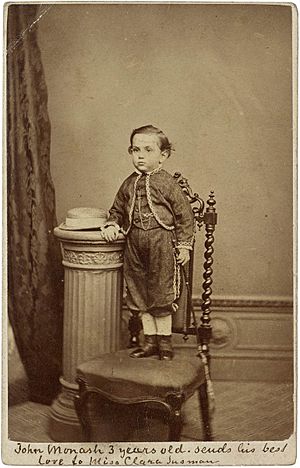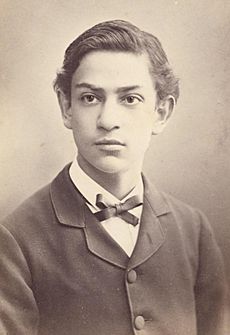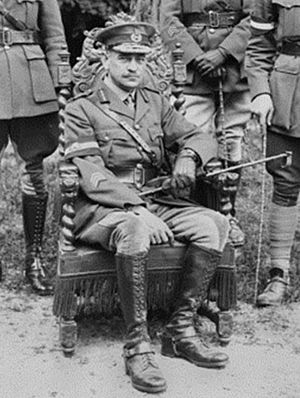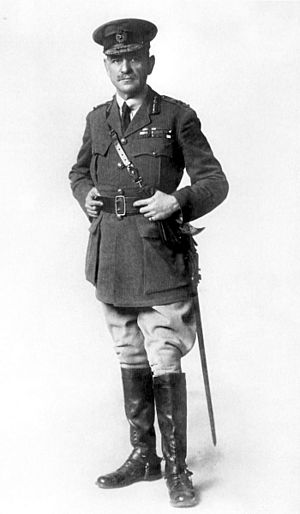John Monash facts for kids
Quick facts for kids
Sir John Monash
|
|
|---|---|
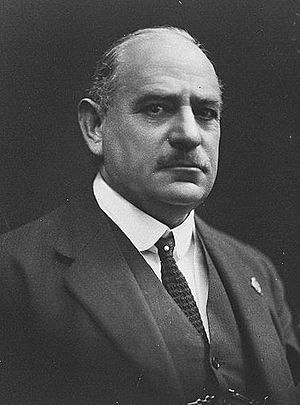
Sir John Monash c.1920s
|
|
| Born | 27 June 1865 Melbourne, Victoria, Australia |
| Died | 8 October 1931 (aged 66) Melbourne, Victoria, Australia |
| Allegiance | Australia |
| Service/ |
Australian Army |
| Years of service | 1884–1920 |
| Rank | General |
| Service number | 52 |
| Commands held | Australian Corps (1918) 3rd Division (1916–1918) 4th Infantry Brigade (1914–1916) 13th Infantry Brigade (1913–1914) |
| Battles/wars | First World War |
| Awards | Knight Grand Cross of the Order of St Michael and St George Knight Commander of the Order of the Bath Volunteer Decoration Mentioned in Despatches (6) Grand Officer of the Legion of Honour (France) Croix de Guerre (France) Grand Officer of the Order of the Crown (Belgium) Croix de Guerre (Belgium) Distinguished Service Medal (United States) |
| Other work | Manager State Electricity Commission of Victoria (1920–1931) Vice-Chancellor University of Melbourne (1923–1931) |
General Sir John Monash (27 June 1865 – 8 October 1931) was an amazing Australian engineer and a brave military leader during the First World War. He was known for his smart thinking and careful planning. Before the war, he led the 13th Infantry Brigade. When the war started, he became the commander of the 4th Brigade in Egypt and fought in the Gallipoli campaign.
In 1916, he took charge of the new 3rd Division in France. By May 1918, he became the commander of the Australian Corps. This was the largest group of soldiers on the Western Front at that time. Many people believe Monash was one of the best Allied generals of the First World War. He is also one of the most famous commanders in Australian history.
Contents
Early Life and Education
John Monash was born in West Melbourne, Victoria, Australia, on 27 June 1865. His parents, Louis and Bertha Monash, were from Poland. They spoke German as their first language. John grew up speaking, reading, and writing German very well.
In 1874, his family moved to Jerilderie in New South Wales. His father ran a store there. John later said he met the famous bushranger Ned Kelly during a raid in 1879. John was a very bright student. His family was told to move back to Melbourne so he could get the best education. They did this in 1877.
Monash went to Scotch College, Melbourne. He passed his university entrance exams when he was only 14. At 16, he was the top student in his school. He studied at the University of Melbourne. He earned degrees in engineering, arts, and law. He even got a special Doctor of Engineering degree in 1921.
On 8 April 1891, Monash married Hannah Victoria Moss. They had one child, a daughter named Bertha, in 1893.
Engineering Career and Early Military Service
Monash worked as a civil engineer. He helped bring reinforced concrete to Australia. This was a new and strong way to build things. He worked on bridges and railways. Later, he started his own engineering companies. He became a leader in his field. He was even president of the Victorian Institute of Engineers.
In 1884, Monash joined the militia, which was like a part-time army. He quickly moved up the ranks. By 1897, he was a major. In 1908, he became a lieutenant-colonel. He was given command of the 13th Infantry Brigade in 1912. He was promoted to colonel in 1913.
First World War
Gallipoli Campaign
When the First World War began in August 1914, Monash became a full-time army officer. He was first appointed as a chief censor in Australia. But he wanted to be on the battlefield. In September, he was made commander of the 4th Infantry Brigade. This brigade had four battalions of soldiers. Some people had concerns about his background, but Monash was supported by other high-ranking officers.
His brigade trained in Australia and then sailed to Egypt in December 1914. In Egypt, his brigade joined the New Zealand and Australian Division. In April 1915, they took part in the Gallipoli campaign against the Turkish forces. Monash's brigade defended a key area, and the valley behind it became known as "Monash Valley." He showed great leadership and planning skills. In July, he was promoted to brigadier general.
In August, Monash's brigade took part in a big attack to break the fighting. They faced tough resistance and difficult land. The attack did not succeed. By mid-August, Monash's brigade had lost many soldiers. In November, the 4th Brigade returned to Gallipoli. Monash used his engineering knowledge to make their positions stronger for winter. In December, they were ordered to leave the peninsula.
After leaving Gallipoli, Monash returned to Egypt. The Australian army was reorganized and grew larger. Monash's brigade was split to help form a new brigade. They also took on defensive duties along the Suez Canal. On 25 April 1916, the first anniversary of the Gallipoli landing, Monash and his men celebrated Anzac Day.
Fighting on the Western Front
In June 1916, Monash and his troops moved to the Western Front in France. On 10 July, Monash was promoted to major general. He was put in charge of the Australian 3rd Division. He trained his division very carefully in England.
When they arrived on the Western Front in November 1916, they fought in major battles like Messines, Broodseinde, and the First Battle of Passchendaele. They had some successes, but also suffered many losses. The British leaders were impressed by Monash. He was told that he would soon command a larger group of soldiers.
Monash's division spent the winter of 1917–1918 near Ploegsteert. In early 1918, the Germans launched a big attack. Monash's 3rd Division helped defend the area around Amiens. Monash later said that the recapture of Villers-Bretonneux on 25 April 1918 was a turning point in the war.
Leading the Australian Corps
On 1 June 1918, Monash was promoted to lieutenant general. He became the commander of the Australian Corps. This was the largest group of soldiers on the Western Front.
Monash was known for his deep knowledge of military matters, engineering, and business. This meant his plans were always very detailed and well thought out. He became more effective the higher he rose in the army.
At the Battle of Hamel on 4 July 1918, Monash led the 4th Australian Division. They were supported by British tanks and American troops. They won a small but very important victory for the Allies.
On 8 August 1918, the Battle of Amiens began. Allied troops, led by the Australian Corps under Monash, attacked the Germans. Monash made sure his troops captured enemy artillery first. This helped protect his attacking forces. This battle was a huge victory for the Allies. The German leader, General Erich Ludendorff, called it "the black day of the German Army."
On 12 August 1918, King George V knighted Monash on the battlefield. This was a very special honor.
The Australians then won more victories under Monash at places like Chuignes, Mont St Quentin, and Peronne. The battle of Mont St Quentin was a stunning blow to the Germans. It helped the Allies take control of a key position in France.
Monash had 208,000 men under his command, including many inexperienced American soldiers. He planned the attack on the strong German defenses called the Hindenburg Line. The Allies broke through this line by 5 October 1918. The war was almost over. On 5 October, Germany asked for an immediate end to the fighting.
By the end of the war, Monash was famous for his intelligence, leadership, and clever ideas. He earned the respect and loyalty of his soldiers. His motto was "Feed your troops on victory." Many British officers respected him greatly. Field Marshal Bernard Montgomery later called Monash "the best general on the western front in Europe."
For his great service, Monash received many honors. He was made a Knight Grand Cross of the Order of St Michael and St George. He also received awards from France, Belgium, and the United States. The Australian Government promoted him to the full rank of general in 1929. This was to recognize his long and important service.
After the War
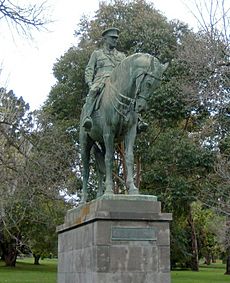
After the war ended in November 1918, Prime Minister William Hughes asked Monash to lead a new department. This department was in charge of bringing Australian troops home from Europe.
In 1919, Monash wrote a book called 'The Australian Victories in France in 1918'. It was published in 1920. Monash was a strong supporter of using all parts of the army together. This included infantry (foot soldiers), aircraft, artillery (big guns), and tanks.
He returned to Australia on 26 December 1919 and received a warm welcome. He was promoted to lieutenant-general in 1920 and then returned to the reserves.
Sadly, Monash's wife, Vic, died in 1920. After the war, Monash took on important civilian jobs. He became the head of the State Electricity Commission of Victoria (SECV) in 1920. He was also the vice-chancellor of the University of Melbourne from 1923 until he died. Monash helped start the first Rotary Club in Melbourne. He also became president of the Zionist Federation of Australia and New Zealand.
In 1923, he helped organize "special constables" to restore order during a police strike. He was also a main organizer of the yearly ANZAC Day ceremonies. He helped plan Melbourne's big war memorial, the Shrine of Remembrance. Monash received many awards from universities and other countries. People in the 1920s widely saw him as the greatest living Australian.
Monash died in Melbourne on 8 October 1931 from a heart attack. He was given a state funeral. About 300,000 people came to pay their respects. This was the largest funeral crowd in Australia at that time. He was buried in Brighton General Cemetery. He asked that his tombstone simply say "John Monash." He was survived by his daughter, Bertha.
Legacy
Military Impact
The British historian A. J. P. Taylor said Monash was "the only general of creative originality produced by the First World War." Monash changed Australian military thinking in three main ways. First, he was the first Australian to fully command Australian forces. He often made his own decisions, even with his British superiors. Second, he believed a commander's most important job was to keep his troops safe and well. Finally, he showed how important it was to plan carefully and use all parts of the army together. This included support services like food, medical care, and recreation. Soldiers remembered that during the Battle of Hamel, Monash even arranged for hot meals to be delivered to the front line.
Cultural Impact
To honor his lasting influence, Monash's face is on Australia's highest value money note, the $100. Monash's success showed how accepting Australian society was. It also showed Australians that their country was diverse and made up of many different backgrounds. According to his biographer, Geoffrey Serle, Monash's presence made anti-Jewish feelings "impossible in Australia."
Places and Things Named After Monash
Many places and things are named after Sir John Monash:
- Monash University, a big university in Victoria.
- City of Monash, a local government area in Melbourne.
- Division of Monash, a voting area in Victoria.
- Monash Medical Centre, a hospital in Melbourne.
- Monash Freeway, a major road in Melbourne.
- John Monash Scholarships, awards for Australians to study overseas.
- John Monash Science School, a special science school in Victoria.
- The town of Monash in South Australia.
- Kfar Monash ("Monash village") in Israel.
- The suburb of Monash in Canberra.
- Sir John Monash Stakes, a horse race.
- Monash Country Club in Ingleside, Sydney.
- Sir John Monash Drive in Caulfield East, Victoria.
- 306 Monash Army Cadet Unit.
- Sir John Monash Centre, a special center in France that tells his story.
- General Monash Branch – Royal Canadian Legion in Winnipeg, Canada.
Calls for Posthumous Promotion
Since 2013, some people have wanted Monash to be promoted to the rank of field marshal after his death. This would make him only the fourth person to hold this very high rank in Australia. Supporters say he was not promoted during his life because of unfair treatment.
However, Monash was recognized by the Australian Government. He was promoted to the full rank of general in 1929. Some historians and military experts believe that promoting him again after his death is not necessary. They say it would not add to his already amazing record. In 2018, the Australian Prime Minister, Malcolm Turnbull, announced that Monash would not be promoted posthumously to field marshal.
See also
 In Spanish: John Monash para niños
In Spanish: John Monash para niños
- 1916 Pioneer Exhibition Game


